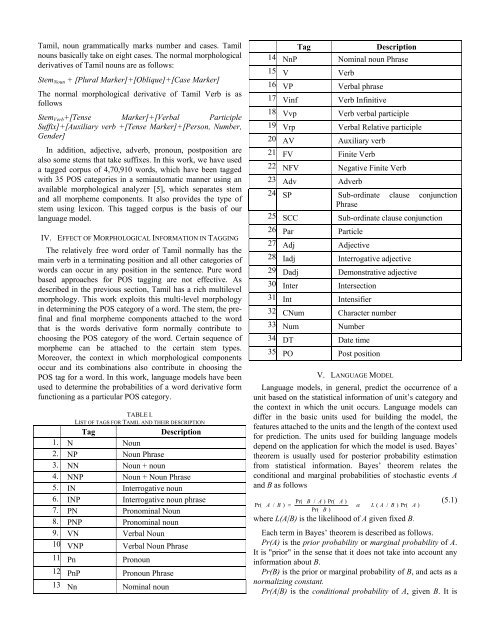Morpheme based Language Model for Tamil Part-of-Speech Tagging
Morpheme based Language Model for Tamil Part-of-Speech Tagging
Morpheme based Language Model for Tamil Part-of-Speech Tagging
Create successful ePaper yourself
Turn your PDF publications into a flip-book with our unique Google optimized e-Paper software.
<strong>Tamil</strong>, noun grammatically marks number and cases. <strong>Tamil</strong><br />
nouns basically take on eight cases. The normal morphological<br />
derivatives <strong>of</strong> <strong>Tamil</strong> nouns are as follows:<br />
Stem Noun + [Plural Marker]+[Oblique]+[Case Marker]<br />
The normal morphological derivative <strong>of</strong> <strong>Tamil</strong> Verb is as<br />
follows<br />
Stem Verb +[Tense Marker]+[Verbal <strong>Part</strong>iciple<br />
Suffix]+[Auxiliary verb +[Tense Marker]+[Person, Number,<br />
Gender]<br />
In addition, adjective, adverb, pronoun, postposition are<br />
also some stems that take suffixes. In this work, we have used<br />
a tagged corpus <strong>of</strong> 4,70,910 words, which have been tagged<br />
with 35 POS categories in a semiautomatic manner using an<br />
available morphological analyzer [5], which separates stem<br />
and all morpheme components. It also provides the type <strong>of</strong><br />
stem using lexicon. This tagged corpus is the basis <strong>of</strong> our<br />
language model.<br />
IV. EFFECT OF MORPHOLOGICAL INFORMATION IN TAGGING<br />
The relatively free word order <strong>of</strong> <strong>Tamil</strong> normally has the<br />
main verb in a terminating position and all other categories <strong>of</strong><br />
words can occur in any position in the sentence. Pure word<br />
<strong>based</strong> approaches <strong>for</strong> POS tagging are not effective. As<br />
described in the previous section, <strong>Tamil</strong> has a rich multilevel<br />
morphology. This work exploits this multi-level morphology<br />
in determining the POS category <strong>of</strong> a word. The stem, the prefinal<br />
and final morpheme components attached to the word<br />
that is the words derivative <strong>for</strong>m normally contribute to<br />
choosing the POS category <strong>of</strong> the word. Certain sequence <strong>of</strong><br />
morpheme can be attached to the certain stem types.<br />
Moreover, the context in which morphological components<br />
occur and its combinations also contribute in choosing the<br />
POS tag <strong>for</strong> a word. In this work, language models have been<br />
used to determine the probabilities <strong>of</strong> a word derivative <strong>for</strong>m<br />
functioning as a particular POS category.<br />
TABLE I.<br />
LIST OF TAGS FOR TAMIL AND THEIR DESCRIPTION<br />
Tag<br />
Description<br />
1. N Noun<br />
2. NP Noun Phrase<br />
3. NN Noun + noun<br />
4. NNP Noun + Noun Phrase<br />
5. IN Interrogative noun<br />
6. INP Interrogative noun phrase<br />
7. PN Pronominal Noun<br />
8. PNP Pronominal noun<br />
9. VN Verbal Noun<br />
10 VNP Verbal Noun Phrase<br />
11 Pn Pronoun<br />
12 PnP Pronoun Phrase<br />
13 Nn Nominal noun<br />
Tag<br />
Description<br />
14 NnP Nominal noun Phrase<br />
15 V Verb<br />
16 VP Verbal phrase<br />
17 Vinf Verb Infinitive<br />
18 Vvp Verb verbal participle<br />
19 Vrp Verbal Relative participle<br />
20 AV Auxiliary verb<br />
21 FV Finite Verb<br />
22 NFV Negative Finite Verb<br />
23 Adv Adverb<br />
24 SP Sub-ordinate clause conjunction<br />
Phrase<br />
25 SCC Sub-ordinate clause conjunction<br />
26 Par <strong>Part</strong>icle<br />
27 Adj Adjective<br />
28 Iadj Interrogative adjective<br />
29 Dadj Demonstrative adjective<br />
30 Inter Intersection<br />
31 Int Intensifier<br />
32 CNum Character number<br />
33 Num Number<br />
34 DT Date time<br />
35 PO Post position<br />
V. LANGUAGE MODEL<br />
<strong>Language</strong> models, in general, predict the occurrence <strong>of</strong> a<br />
unit <strong>based</strong> on the statistical in<strong>for</strong>mation <strong>of</strong> unit’s category and<br />
the context in which the unit occurs. <strong>Language</strong> models can<br />
differ in the basic units used <strong>for</strong> building the model, the<br />
features attached to the units and the length <strong>of</strong> the context used<br />
<strong>for</strong> prediction. The units used <strong>for</strong> building language models<br />
depend on the application <strong>for</strong> which the model is used. Bayes’<br />
theorem is usually used <strong>for</strong> posterior probability estimation<br />
from statistical in<strong>for</strong>mation. Bayes’ theorem relates the<br />
conditional and marginal probabilities <strong>of</strong> stochastic events A<br />
and B as follows<br />
Pr( A / B ) =<br />
Pr( B / A ) Pr(<br />
Pr( B )<br />
A )<br />
α<br />
L ( A / B ) Pr( A )<br />
where L(A|B) is the likelihood <strong>of</strong> A given fixed B.<br />
(5.1)<br />
Each term in Bayes’ theorem is described as follows.<br />
Pr(A) is the prior probability or marginal probability <strong>of</strong> A.<br />
It is "prior" in the sense that it does not take into account any<br />
in<strong>for</strong>mation about B.<br />
Pr(B) is the prior or marginal probability <strong>of</strong> B, and acts as a<br />
normalizing constant.<br />
Pr(A|B) is the conditional probability <strong>of</strong> A, given B. It is

















